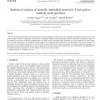Free Online Productivity Tools
i2Speak
i2Symbol
i2OCR
iTex2Img
iWeb2Print
iWeb2Shot
i2Type
iPdf2Split
iPdf2Merge
i2Bopomofo
i2Arabic
i2Style
i2Image
i2PDF
iLatex2Rtf
Sci2ools
101
Voted
IJON
2007
2007
Statistical analysis of spatially embedded networks: From grid to random node positions
Many conceptual studies of local cortical networks assume completely random wiring. For spatially extended networks, however, such random graph models are inadequate. The geometry of neuronal dendrites and axons induces distance-dependent connectivity. Here, we investigated several types of spatial embedding that are widely used in modeling. Both regarding the spatial positions of nodes and in terms of node connectivity, we considered the full range between regularity and randomness, and characterized the various networks in the framework of stochastic graph theory. We found that many characteristic network properties are highly sensitive to the degree of randomness in the spatial arrangement of nodes, especially in the case of networks dominated by local connections. Our findings have potentially important implications for the design of large-scale network models. r 2006 Elsevier B.V. All rights reserved.
Related Content
| Added | 15 Dec 2010 |
| Updated | 15 Dec 2010 |
| Type | Journal |
| Year | 2007 |
| Where | IJON |
| Authors | Nicole Voges, Ad Aertsen, Stefan Rotter |
Comments (0)

